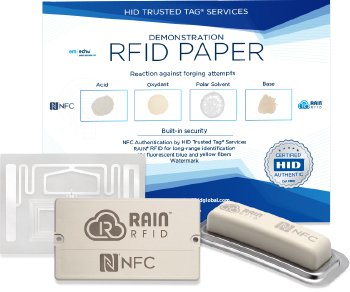Retail and Beyond: The Convergence of NFC and RAIN® RFID
- Near Field Communication (NFC)
- RAIN® RFID (formerly known as UHF RFID)
While NFC (based on high-frequency - HF) is easy to use by anyone with a modern smartphone by “tapping” a tag, RAIN RFID (ultrahigh-frequency - UHF) tags are primarily used for professional logistics applications where long-reading distances and bulk scanning, e.g. of a pallet or a truckload of goods, are required.
New generations of RFID chips and tags that combine both technologies have entered the market. In this blog, I will lay out the cool benefits and applications in detail.
NFC’s Cool Value:
- To access the data or initiate engagement, you no longer need dedicated RFID reader equipment or software. Any modern NFC-enabled smartphone may be used as a reader.
- Consumer interaction for brand authentication or enhanced customer loyalty communication is possible.
- Highly secure cryptographic authentication can be integrated without special software by using HID Trusted Tag® Services. It provides proof of presence and genuine product verification without an APP.
- True IoT dedicated interaction with an individual item or product by a simple “tap”.
[svg: 54026]
RAIN RFID Cool Factor:
- Improved logistics using long-range bulk scanning allows clients to read whole pallets or truckloads of goods quickly and accurately.
- Highly standardized and interoperable regardless of applications.
- Variety of reader and antenna designs to match a multitude of industrial use cases.

Combining These Technologies is Even Better
While RAIN RFID is used in most industrial and logistics uses cases due to its long range and bulk scanning capabilities, there are limitations when it comes to end-user interaction due to the required special RAIN RFID readers. Also, when intentional interaction with only one item within a set is desired, the long reading distance of RAIN RFID can become a disadvantage. Fortunately, modern tag designs now allow combining the best of both worlds. This can be achieved in two ways:- Separate RAIN RFID and NFC chips In this case, a RAIN RFID chip + antenna and an NFC chip + antenna are embedded into the same RFID tag housing. With this method, any chip combination from the market across different vendors is supported. This allows utilization of specific properties from each chip. Additionally, this tag design is ideal for migration scenarios because the existing infrastructure may be re-used. The caveat is both chips do not talk to each other and need to be programmed and read separately.
- One chip that can utilize RAIN RFID and NFC In this case, a single chip can talk via both interfaces. This has the advantage of shared memory and serial numbers efficiently accessed through either interface. For newly installed applications, this is the solution to choose.
Real-Life Applications
Today, there are two main applications for this combined technology: Retail Applying a combo tag allows the RAIN RFID capability to power supply chain, logistics and inventory applications in the backend. However, when the product is sold in the storefront, the trusted NFC technology can be easily used by consumers or employees with their mobile phones to determine if the product is genuine or interact with the brand via the web to read instructions, re-order supplemental materials or for marketing engagement. Industrial RTI and LogisticsUsing a combo tag does not need to necessarily involve consumers. Industrial Returnable Transport Items (RTI) like steel kegs or containers can also benefit from this technology. For example, a keg would be identified via RAIN RFID during its refill, cleaning and shipping lifecycle. The user of the keg, a bar or restaurant can use an NFC interface to identify content or expiration dates, or place reorders with a simple tap from a smartphone, thereby avoiding investments into RFID readers and software. This also saves time and resources to manually reorder new supply.

Furthermore, migration scenarios, from an existing HF (NFC or non-NFC) workflow to RAIN RFID (UHF), are perfectly supported by combo RFID tags. The reader and tagged product infrastructure can be gradually exchanged over time instead of all at once.
Outlook Quite often a converged technology tag does not have to be an either-or decision. Modern RFID combo tags provide the best of both frequency worlds and are efficient to use for both logistics and itemized scenarios. The extended use cases and saved infrastructure costs strongly support the amortization of such RFID solutions around the globe.Richard Aufreiter, VP Product Marketing, HID Global is driving HID’s diverse and flexible portfolio of identification technologies across frequencies and applications. With vast expertise in RFID/NFC, encryption systems, PKI, biometry and mobile security, he brings over 20 years of leading product management and engineering in the IT and RFID industry.
